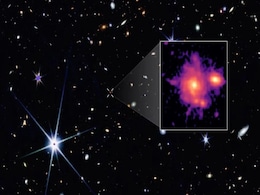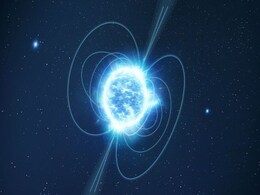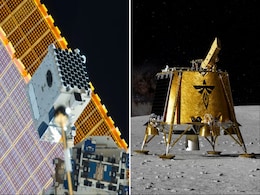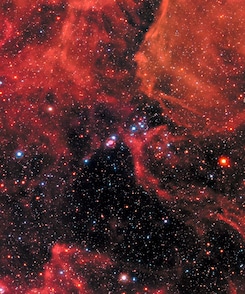Nasa Telescope
- All
- News
- Videos
- Web Stories
-

Neighbouring Planets To Faraway Galaxies, NASA Shares Stunning Pics To Celebrate Hubble Telescope's 35th Anniversary
- Thursday April 24, 2025
- Science | Edited by Bhavya Sukheja
To mark the 35th anniversary of the Hubble Space Telescope, the US space agency NASA released new high-definition photos taken with the technological marvel.
-
 www.ndtv.com
www.ndtv.com
-

NASA James Webb Space Telescope Discovers Farthest Spiral Galaxy, Reveals Clues About Galactic Evolution
- Saturday April 19, 2025
- Written by Gadgets 360 Staff
JWST discovers Zhúlóng, the earliest Milky Way-like galaxy, 800 million years after the Big Bang explosion occurred.
-
 www.gadgets360.com
www.gadgets360.com
-

NASA Hubble Space Telescope Helps Confirm the First Solitary Black Hole
- Friday April 18, 2025
- Written by Gadgets 360 Staff
In the Sagittarius constellation, a lone and first-ever solitary black hole has been discovered by a team of scientists. Although the discovery began in the year 2011, the observations have confirmed it recently. The size of this black hole is as massive as seven times of the sun. Despite the conflicts and differences of observations by another tea...
-
 www.gadgets360.com
www.gadgets360.com
-

Signs of Alien Life Detected on Nearby Exoplanet Using NASA’s James Webb Space Telescope
- Friday April 18, 2025
- Written by Gadgets 360 Staff
Astronomers have detected possible biosignature gases, including dimethyl sulfide (DMS), in the atmosphere of exoplanet K2-18b using NASA’s James Webb Space Telescope. Located in the habitable zone, this “Hycean” world may host a vast ocean and a hydrogen-rich atmosphere, raising intriguing possibilities about alien life. Further research is ...
-
 www.gadgets360.com
www.gadgets360.com
-

NASA’s Hubble Space Telescope Shares Detailed Mosaic of the Sombrero Galaxy
- Friday April 18, 2025
- Written by Gadgets 360 Staff
NASA’s Hubble reveals a detailed view of the Galactic favourite, the Sombrero Galaxy, telling about the rare shape of the galaxy. The Sombrero Galaxy is found to have metal-rich stars in its outer region. This research has a future scope of getting deeper insights into its formation by using the advanced imaging technique of Hubble.
-
 www.gadgets360.com
www.gadgets360.com
-

NASA’s Hubble Space Telescope Tracks a Neutron Star With Mysterious Origin
- Wednesday April 16, 2025
- Written by Gadgets 360 Staff
NASA’s Hubble Space Telescope spotted a rogue magnetar, dubbed SGR 0501+4516, traversing our galaxy for a significantly long time. As per claims by scientists, it was first discovered in the year 2008 by NASA's Swift Observatory as intense flashes of gamma rays in the outer area of the Milky Way
-
 www.gadgets360.com
www.gadgets360.com
-

NASA’s James Webb Space Telescope Reveals the Complex Structure of a Planetary Nebula
- Wednesday April 16, 2025
- Written by Gadgets 360 Staff
NASA's James Webb Space Telescope has unveiled the complex character of NGC 1514, a planetary nebula developing over at least 4,000 years. Only seen in infrared light, the nebula's rings now resemble "fuzzy" clusters set in twisted patterns. A network of sharper holes near the centre stars indicates where faster material punched through.
-
 www.gadgets360.com
www.gadgets360.com
-

NASA's Webb Telescope Releases Clearest Pictures Of Dying Stars
- Wednesday April 16, 2025
- World News | Edited by NDTV News Desk
NASA has released some stunning images of dying stars, offering the most in-depth view of the planetary nebula NGC 1514 to date.
-
 www.ndtv.com
www.ndtv.com
-

NASA’s SPHEREx Mission Sends First Space Images Before Full Sky Survey
- Thursday April 3, 2025
- Written by Gadgets 360 Staff
NASA’s SPHEREx telescope has captured its first images from space, marking a critical milestone before its full-sky infrared survey begins. The observatory, launched on March 11, recorded thousands of light sources, including distant galaxies and stars. Unlike other space telescopes, SPHEREx is designed for large-scale cosmic mapping, scanning th...
-
 www.gadgets360.com
www.gadgets360.com
-

JWST Captures Unseen Details of Exoplanets in HR 8799 and 51 Eridani Systems
- Thursday April 3, 2025
- Written by Gadgets 360 Staff
The James Webb Space Telescope (JWST) has captured groundbreaking images of exoplanets in the HR 8799 and 51 Eridani systems. By modifying its coronagraphs, astronomers allowed more starlight to pass through, revealing clearer planetary details. The study, published in The Astrophysical Journal Letters, highlights the first successful detection of ...
-
 www.gadgets360.com
www.gadgets360.com
-

James Webb Telescope Captures Neptune’s Auroras in Stunning Detail
- Monday March 31, 2025
- Written by Gadgets 360 Staff
The James Webb Space Telescope has provided the first-ever direct images of Neptune’s auroras, revealing surprising details about the ice giant’s atmosphere. Unlike auroras on Earth, Jupiter, or Saturn, Neptune’s auroras appear across unexpected locations due to its tilted and offset magnetic field. Scientists also detected the presence of H...
-
 www.gadgets360.com
www.gadgets360.com
-

What Is Dark Energy? The Mystery Behind The Expanding Universe
- Thursday March 20, 2025
- World News | Agence France-Presse
Dark energy makes up roughly 70 percent of the universe, yet we know nothing about it. Around 25 percent of the universe is the equally mysterious dark matter, leaving just five percent for everything that we can see and touch.
-
 www.ndtv.com
www.ndtv.com
-

NASA's Webb Captures First Direct Images Of Carbon Dioxide Outside Solar System
- Tuesday March 18, 2025
- Science | Edited by Ritu Singh
This finding provides compelling evidence that the giant planets in HR 8799 formed through core accretion, a process similar to the formation of Jupiter and Saturn.
-
 www.ndtv.com
www.ndtv.com
-

Hubble Telescope Captures NGC 4536, a Starburst Galaxy with Intense Star Formation
- Wednesday March 26, 2025
- Written by Gadgets 360 Staff
NASA’s Hubble Space Telescope has captured a striking image of NGC 4536, a starburst galaxy 50 million light-years away in the Virgo constellation. The galaxy’s sweeping spiral arms are filled with young blue star clusters and ionized hydrogen gas, indicating rapid star formation. Astronomers believe its bar-like structure channels gas toward t...
-
 www.gadgets360.com
www.gadgets360.com
-

NASA’s Space Station Research Aids Lunar Missions With Key Technologies
- Tuesday March 18, 2025
- Written by Gadgets 360 Staff
Research aboard the International Space Station is advancing lunar exploration. Firefly Aerospace’s Blue Ghost Mission-1, which landed on 2 March 2025, carries three experiments linked to space station studies. LEXI observes X-ray emissions to study space weather, RadPC tests radiation-tolerant computing, and LuGRE detects GNSS signals for lunar ...
-
 www.gadgets360.com
www.gadgets360.com
-

Neighbouring Planets To Faraway Galaxies, NASA Shares Stunning Pics To Celebrate Hubble Telescope's 35th Anniversary
- Thursday April 24, 2025
- Science | Edited by Bhavya Sukheja
To mark the 35th anniversary of the Hubble Space Telescope, the US space agency NASA released new high-definition photos taken with the technological marvel.
-
 www.ndtv.com
www.ndtv.com
-

NASA James Webb Space Telescope Discovers Farthest Spiral Galaxy, Reveals Clues About Galactic Evolution
- Saturday April 19, 2025
- Written by Gadgets 360 Staff
JWST discovers Zhúlóng, the earliest Milky Way-like galaxy, 800 million years after the Big Bang explosion occurred.
-
 www.gadgets360.com
www.gadgets360.com
-

NASA Hubble Space Telescope Helps Confirm the First Solitary Black Hole
- Friday April 18, 2025
- Written by Gadgets 360 Staff
In the Sagittarius constellation, a lone and first-ever solitary black hole has been discovered by a team of scientists. Although the discovery began in the year 2011, the observations have confirmed it recently. The size of this black hole is as massive as seven times of the sun. Despite the conflicts and differences of observations by another tea...
-
 www.gadgets360.com
www.gadgets360.com
-

Signs of Alien Life Detected on Nearby Exoplanet Using NASA’s James Webb Space Telescope
- Friday April 18, 2025
- Written by Gadgets 360 Staff
Astronomers have detected possible biosignature gases, including dimethyl sulfide (DMS), in the atmosphere of exoplanet K2-18b using NASA’s James Webb Space Telescope. Located in the habitable zone, this “Hycean” world may host a vast ocean and a hydrogen-rich atmosphere, raising intriguing possibilities about alien life. Further research is ...
-
 www.gadgets360.com
www.gadgets360.com
-

NASA’s Hubble Space Telescope Shares Detailed Mosaic of the Sombrero Galaxy
- Friday April 18, 2025
- Written by Gadgets 360 Staff
NASA’s Hubble reveals a detailed view of the Galactic favourite, the Sombrero Galaxy, telling about the rare shape of the galaxy. The Sombrero Galaxy is found to have metal-rich stars in its outer region. This research has a future scope of getting deeper insights into its formation by using the advanced imaging technique of Hubble.
-
 www.gadgets360.com
www.gadgets360.com
-

NASA’s Hubble Space Telescope Tracks a Neutron Star With Mysterious Origin
- Wednesday April 16, 2025
- Written by Gadgets 360 Staff
NASA’s Hubble Space Telescope spotted a rogue magnetar, dubbed SGR 0501+4516, traversing our galaxy for a significantly long time. As per claims by scientists, it was first discovered in the year 2008 by NASA's Swift Observatory as intense flashes of gamma rays in the outer area of the Milky Way
-
 www.gadgets360.com
www.gadgets360.com
-

NASA’s James Webb Space Telescope Reveals the Complex Structure of a Planetary Nebula
- Wednesday April 16, 2025
- Written by Gadgets 360 Staff
NASA's James Webb Space Telescope has unveiled the complex character of NGC 1514, a planetary nebula developing over at least 4,000 years. Only seen in infrared light, the nebula's rings now resemble "fuzzy" clusters set in twisted patterns. A network of sharper holes near the centre stars indicates where faster material punched through.
-
 www.gadgets360.com
www.gadgets360.com
-

NASA's Webb Telescope Releases Clearest Pictures Of Dying Stars
- Wednesday April 16, 2025
- World News | Edited by NDTV News Desk
NASA has released some stunning images of dying stars, offering the most in-depth view of the planetary nebula NGC 1514 to date.
-
 www.ndtv.com
www.ndtv.com
-

NASA’s SPHEREx Mission Sends First Space Images Before Full Sky Survey
- Thursday April 3, 2025
- Written by Gadgets 360 Staff
NASA’s SPHEREx telescope has captured its first images from space, marking a critical milestone before its full-sky infrared survey begins. The observatory, launched on March 11, recorded thousands of light sources, including distant galaxies and stars. Unlike other space telescopes, SPHEREx is designed for large-scale cosmic mapping, scanning th...
-
 www.gadgets360.com
www.gadgets360.com
-

JWST Captures Unseen Details of Exoplanets in HR 8799 and 51 Eridani Systems
- Thursday April 3, 2025
- Written by Gadgets 360 Staff
The James Webb Space Telescope (JWST) has captured groundbreaking images of exoplanets in the HR 8799 and 51 Eridani systems. By modifying its coronagraphs, astronomers allowed more starlight to pass through, revealing clearer planetary details. The study, published in The Astrophysical Journal Letters, highlights the first successful detection of ...
-
 www.gadgets360.com
www.gadgets360.com
-

James Webb Telescope Captures Neptune’s Auroras in Stunning Detail
- Monday March 31, 2025
- Written by Gadgets 360 Staff
The James Webb Space Telescope has provided the first-ever direct images of Neptune’s auroras, revealing surprising details about the ice giant’s atmosphere. Unlike auroras on Earth, Jupiter, or Saturn, Neptune’s auroras appear across unexpected locations due to its tilted and offset magnetic field. Scientists also detected the presence of H...
-
 www.gadgets360.com
www.gadgets360.com
-

What Is Dark Energy? The Mystery Behind The Expanding Universe
- Thursday March 20, 2025
- World News | Agence France-Presse
Dark energy makes up roughly 70 percent of the universe, yet we know nothing about it. Around 25 percent of the universe is the equally mysterious dark matter, leaving just five percent for everything that we can see and touch.
-
 www.ndtv.com
www.ndtv.com
-

NASA's Webb Captures First Direct Images Of Carbon Dioxide Outside Solar System
- Tuesday March 18, 2025
- Science | Edited by Ritu Singh
This finding provides compelling evidence that the giant planets in HR 8799 formed through core accretion, a process similar to the formation of Jupiter and Saturn.
-
 www.ndtv.com
www.ndtv.com
-

Hubble Telescope Captures NGC 4536, a Starburst Galaxy with Intense Star Formation
- Wednesday March 26, 2025
- Written by Gadgets 360 Staff
NASA’s Hubble Space Telescope has captured a striking image of NGC 4536, a starburst galaxy 50 million light-years away in the Virgo constellation. The galaxy’s sweeping spiral arms are filled with young blue star clusters and ionized hydrogen gas, indicating rapid star formation. Astronomers believe its bar-like structure channels gas toward t...
-
 www.gadgets360.com
www.gadgets360.com
-

NASA’s Space Station Research Aids Lunar Missions With Key Technologies
- Tuesday March 18, 2025
- Written by Gadgets 360 Staff
Research aboard the International Space Station is advancing lunar exploration. Firefly Aerospace’s Blue Ghost Mission-1, which landed on 2 March 2025, carries three experiments linked to space station studies. LEXI observes X-ray emissions to study space weather, RadPC tests radiation-tolerant computing, and LuGRE detects GNSS signals for lunar ...
-
 www.gadgets360.com
www.gadgets360.com
















![Gadgets 360 With Technical Guruji: Did You Know? [April 6, 2024] Gadgets 360 With Technical Guruji: Did You Know? [April 6, 2024]](https://c.ndtvimg.com/2024-02/mpconh58_did-you-know_640x480_10_February_24.jpg?downsize=245:163)









